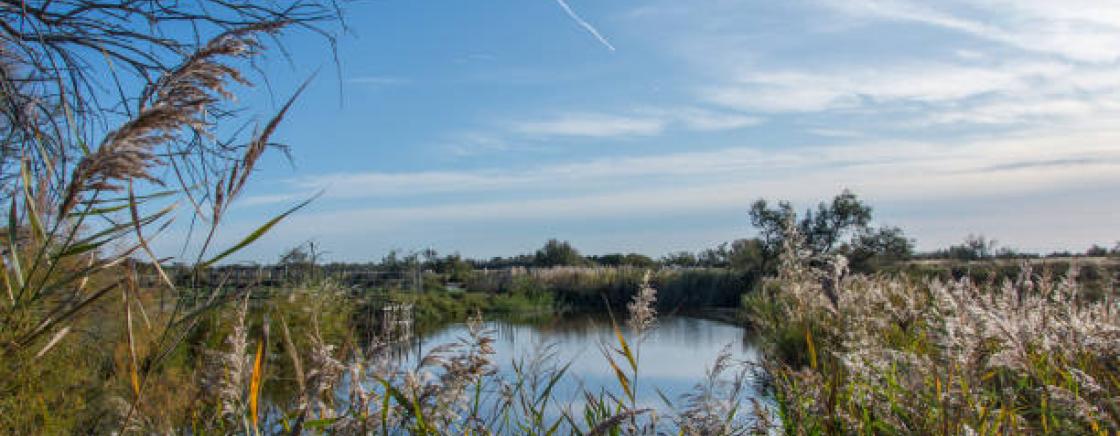
The Gironde and the Arcachon Basin itself are a very rich area, hiding some sumptuous landscapes. You'll no doubt be familiar with the famous Dune du Pilat, or perhaps you've already visited the many fine sandy beaches lining the basin during a stay in Arcachon, whether they be wilder or on the edge of the town's lively quays.
During your stay in Arcachon, you may have missed the natural treasure nestling nearby, which embodies the perfect harmony between fresh and salt water, between dry land and coastal marshes: the Eyre delta. Situated at the mouth of the River Eyre, this delta is an exceptionally rich ecosystem that is much admired by visitors.
From mouth to jetty
The name Delta de l'Eyre comes from the river Eyre, which rises in the Landes region of France and stretches for 135 kilometres through a variety of landscapes before flowing into the Arcachon basin. "Eyre" comes from the Gascon dialect and simply means "water". This river drains freshwater into the Arcachon basin.
Its proximity to the Atlantic Ocean means that the river is subject to the same tides simultaneously. Indeed, it is this phenomenon of rising and falling tides that has contributed to the formation of the delta, thanks to the numerous marine sediments. Over time, these same sediments have created a rather complex network of channels, islands and sandbanks. This complexity creates a veritable natural labyrinth, which some have poetically dubbed "the emerald mosaic". This mix of natural phenomena, and in particular the mixture of fresh and salt water, creates a diversity of ecosystems conducive to a rich biodiversity.
The origin of the Eyre Delta is therefore the result of the interaction between the river and the ocean tides.
A rich and astonishing biodiversity
All these natural features make the Eyre Delta a perfect place for a rich biodiversity, home to a very dense and diverse fauna and flora.
One of the most common species is birds, as the delta is an important area for migratory birds in Europe. It is home to thousands of birds every year, including ducks, waders, herons, spoonbills and storks. The Tech ornithological reserve is an essential bird-watching site.
Fish are another popular species. You'll find mullet, sea bass and even European eels. Numerous invertebrates are also present, including crabs and prawns.
You may also come across various mammals and insects of all kinds. Foxes, roe deer and even wild boar hide and live in this region, living side by side with the enchanting butterflies and dragonflies flying through the foliage flying over the water. Their reflection is made all the more sparkling by the colour of the water. In fact, the water is a distinctive "rusty" colour, due to the presence of a special iron ore called "alios".
In terms of flora, the reeds are the most abundant in the delta marshes. Ranging from 3 to 5 metres in height, the reeds impress us with their long, slender stems adorned with a sort of feather duster that sways in the wind. This species is known to spread very quickly and form a kind of colony, which explains its abundance in the L’Eyre delta.
The second plant you're likely to come across on your walk is the Glasswort, a low, fleshy plant that takes root in soil rich in sea salts, such as that of the Leyre delta. Its shape may remind you of a cactus that has lost its spines, or even a coral branch.
It is thanks to the richness and diversity of this area that the Leyre delta has earned its nickname of "Little Amazon". This ecologically valuable area is an important conservation site for many species, much sought-after by nature lovers for its wildlife and the beauty of its natural landscape.
During your excursion, discover the island of Malprat, which means "bad near" in local dialect. This 140-hectare island is truly impressive, as it lies in the continuity of the L’Eyre delta and hides a very dense and special ecosystem, thanks in particular to its freshwater source. You'll be able to admire the vast expanses of marshy meadows and, if you're lucky, come across the wild and unspoilt nature of the island, which can only be visited in the presence of a guide to ensure it retains its authenticity and natural richness.

Conservation challenges
This unique place is therefore very well preserved, as it represents a number of conservation challenges. Climate change is one of the factors endangering this natural jewel, as it can have an impact on sea levels, water temperatures and the effect of rainfall on migratory birds taking refuge there. Other factors also come into play, such as deterioration in water quality, flood management, habitat loss and urbanisation.
To make the most of this area in a responsible way, we recommend that you book a canoe trip, so that you can be at the heart of this area and surrounded by its wealth. Allow 2 hours and half for the canoe trip, so you can observe every details of the natural environment while enjoying the restful calm offered by nature. A superb activity for your stay in Arcachon, bringing you closer to nature and whetting your appetite before sampling the famous oysters of the Arcachon Bassin!